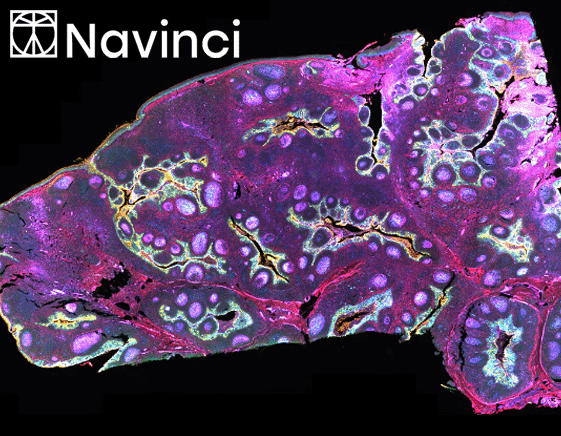Many of you will remember having to memorize numerous cellular signal transduction pathways during your studies – including, most likely, the MAP kinase pathway. This cascade serves as a central regulatory hub in human cells, branching into numerous downstream signaling routes and playing a key role in embryogenesis, cell differentiation, cell growth and programmed cell death [1, 2]. Upon ligand binding to the EGF receptor (EGFR), the G-protein Ras becomes activated and triggers a phosphorylation cascade involving three sequential kinases [1]. In addition to its fundamental physiological functions, the MAPK signaling pathway also harbors substantial oncogenic potential: mutations in the Ras proto-oncogene can cause constitutive receptor-independent activation of the Ras protein. This not only promotes tumorigenesis, but can also give rise to rare genetic disorders known as RASopathies [2].
Due to its high clinical relevance, mapping the MAPK signaling pathway is of great interest to many researchers – and our partner Navinci has now made this possible. With the new Naveni® Plex Omni Service, the entire cascade can be tracked, from the activation of EGFR all the way to the phosphorylation of ERK1, one of the MAP kinases [3]. And the Omni Service goes far beyond the MAPK pathway: the proprietary multiplex in situ Proximity Ligation Assay (misPLA) technology enables the simultaneous detection of up to eight protein-protein interactions, individual proteins or phosphorylation states within their spatial context – ranging from MAPK signaling to immune checkpoint inhibitors to T- and B-cell markers.
These topics await you:
1) Naveni® Plex Omni Service – The First isPLA-Based Multiplexing System
2) The Next Generation of Spatial Interactomics – Carried Out by Experts
3) Eight Steps to Your Results: How the Naveni® Plex Omni Service Works
Naveni® Plex Omni Service – The First isPLA-Based Multiplexing System
On September 30th, 2025, Navinci introduced the new Naveni® Plex Omni Service, giving researchers worldwide access to state-of-the-art spatial interactomics [4]. Using the innovative misPLA technology, protein function and molecular networks can be mapped directly within their spatial context. This provides valuable insights into tumor-stroma communication, immune cell states, and key molecular networks that shape therapy response [3]. The underlying technology is based on antibody-oligonucleotide pairs that generate an amplifiable DNA signal when proteins are in close proximity, thereby visualizing protein interactions and post-translational modifications (Fig. 1). Up to eight such pairs can be used simultaneously. When the respective target epitopes are located sufficiently close to one another, ligation and rolling-circle amplification are triggered, resulting in a strong fluorescence signal (Fig. 1) [5].

The Next Generation of Spatial Interactomics – Carried Out by Experts
The best part of the Naveni® Plex Omni Service? The assay is performed directly by the very experts who developed it. From consultation to data delivery, the entire process is handled by the Navinci team – meaning you can focus entirely on the scientific insights rather than on assay optimization. You may choose freely from 50 verified targets to assemble a customized 4- to 8-plex panel tailored to your research needs. Alternatively, Navinci also offers prevalidated “ready-to-use” panels, including MAPK, immuno-oncology, and TCR/BCR panels [3]. Once the panel has been defined, you simply send in your samples – and from that point onward, you can leave the hands-on work to the experts. Multiple sample types are supported, including FFPE sections and tissue microarrays, fresh-frozen tissue samples, and fixed cultured cells.
Eight Steps to Your Results: How the Naveni® Plex Omni Service Works
- Panel design
Configure your 8-plex in situ Multiplex Proximity Ligation Assay (isPLA) panel from a list of pre-validated targets. Please enter the Biomol referral code “NP-OMNI-BIOMOL” in the Omni Panel Builder (Fig. 2). - Study consultation
Meet with the Omni Service team to discuss project scope, timelines, and image analysis options. - Quotation and terms
You will receive a detailed quote along with all relevant information regarding service conditions. - Sample shipment
Your samples are shipped to Navinci’s headquarters in Uppsala, Sweden, following the clearly defined shipping guidelines. - Assay execution
The next-generation multiplex isPLA assay is performed on your samples directly by the developers of the technology. - Optional: Image analysis
Upon request, image analysis can be performed by specialists at Propath UK. - Data delivery
Your results are securely delivered to you via Pathcore Flow. - Completion and invoicing
After project completion, you will receive the invoice – marking the official end of the service.

Ready for cutting-edge spatial interactomics? Create your own Naveni® Plex Omni Panel now using Navinci’s Omni Panel Builder. Want to learn more? Read the proof-of-concept paper on the misPLA technology in collaboration with Uppsala University and discover additional information in the Naveni® Plex Omni product flyer.
Sources
[1] https://de.wikipedia.org/wiki/MAP-Kinase-Weg, 14.10.2025.
[2] https://flexikon.doccheck.com/de/Ras/Raf/MAPK-Signalweg, 14.10.2025.
[3] https://navinci.se/technology/naveni-plex/naveni-plex-omni-service/, 14.10.2025.
[4] https://navinci.se/naveni-plex-omni-service-launch/, 14.10.2025.
[5] Löf, L., Xu, B., Sinha, T.K., Dahlström, C., Vennberg, J., Larsson Forssén, T., Klaesson, A., Clausson, C.M., Wang, X., Strömberg-Olsson, U., et al. (2025). Spatial mapping of proteins and their activity states in cancer models by multiplex in situ PLA. bioRxiv, 2025.2007.2011.662357.
Preview Image: https://navinci.se/technology/naveni-plex/naveni-plex-omni-service/



